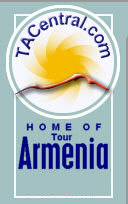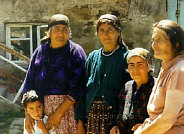THE GEORGIANS
Endoethnonym: KARTVELI. A nation of highly developed ancient culture. The Georgian language belongs to the Kartvelian branch of the Ibero-Caucasian family of languages. Writing is based upon the Georgian alphabet.
By far most Georgians are Orthodox Christians belonging to the Georgian Orthodox Church. The Ajars and the groups of Meskhi and Ingiloy are Sunni Muslims. A small part of the Georgians, the so-called Freydanians (after the Freydan region in Iran) who had been forcibly relocated to Iran by Aga Muhammad-khan Kajar in the early 18th century to Iran, confess Shiism.
Historically, the Georgians and the Armenians are related very closely. Despite the very dissimilar entanglements of their mutual history, the two autochthonous nations of the South Caucasus are extremely close in their cultural traditions, religion and popular outlook.
Eastern Armenia (Armenia today) has never harbored any Georgian settlements; living in Western Armenia (Eastern Anatolia) are the Lahzes – Muslims, members of the Cartvelian subethnic group.
Georgians residing in Armenia today have settled there through mixed marriages, the population being very insignificant, about a hundred persons in all, mostly intellectuals, with practically no migration, living in the capital city only.
THE GERMANS
Endoethnonym: DEUTCHE. Language: German, related to the Germanic group of the Indo-European family of Languages. Writing – Latin-based. Belonging to diverse confessional groups - Catholics, Lutherans, as well as sectarians: Baptists, Adventists, Mennonites, Pentacostalists, et. al.
In Transcaucasia the German colonies appeared in 1817-1819. Those were the arrivals from Wurthenberg inspired by the idea to meet the end of the world at the foot of the sacred mount of Ararat. Later the German communities were joined by migrants of other nationalities, the arrivals from Western Europe: the Swiss, the Dutch, the Italians.
There are no places in today’s Armenia densely populated by the Germans. They are a small community, many live in Yerevan, the rest in the cities Vanadzor, Giumri, Armavir, Abovian, Garni, Biurakan, in districts Noemberian, Artashat, etc.
The urban dwellers are mostly intellectuals, the rural residents mostly farmers.
Most Armenian Germans are Russian-speaking. They learn German as a foreign language within the public school curriculum. The linguistic factor along with the economic problems of the last years and the newly established opportunity to leave for Germany, their historic homeland, has largely affected the migrational processes among the Germans.
The Community is in close cooperation with the German Educational and Cultural Centre of Armenia helping to organize linguistic courses, cultural events, etc.
THE POLES
Endoethnonym: POLYATSI. The language: Polish, belonging to the West Slavic group of the Indo-European family of languages. Writing based upon Latin letters. Mostly Catholics, but there is an insignificant number of Protestants. The Poles living in the CIS countries had been subjected to assimilation in all of its aspects: linguistic, cultural, etc.
In Armenia the Poles appeared in the early 19th century. Those were the servicemen from the Russian Army billeted in Transcaucasia or Turkey and having started families: after the Armenian Genocide of 1915, part of those who had originally settled in Western Armenia, relocated to Eastern Armenia, which was part of Russia. Among the first Polish migrants were some political figures exiled to the Caucasus for political dissent. However, most Poles living now in Armenia came here in the mid-20th century through the massive exile of the Polish military by the Soviet authorities in 1939 to the remote areas of USSR, whence some moved to Transcaucasia, as well as through the evacuation during World War Two.
The number of Poles in Armenia is insignificant, perhaps a few hundred persons. More precise data are not available, since more often than not the poles would prefer to be registered as Russians, Ukrainians, etc. in the population census. Living scattered, mostly in cities: Yerevan, Giumri, Spitak, Vanadzor, Echmiadzin.
The Armenia’s Poles are Russian-speaking, though many are fluent in Armenian. A competence in Polish is almost zero. However, in the last few years an increased interest is detectable towards their own culture, history, etc. – the phenomenon actually occurring in all national groups residing within the Former Soviet Union.
Most Armenia’s Poles are intellectuals: educators, engineers, musicians, lawyers, etc. There are many mixed marriages, including those with the Armenians. The migration is inappreciable.
THE UKRAINIANS
The Ukrainians, endoethnonym: UKRAINTSI, were also called CHERKASY in the 16th – 17th cc, as well as MALOROSSY (Minor Russians) prior to 20th c. The language: Ukrainian, related to the East Slavonic branch of the Indo-European family of languages.
A fairly high percentage of Ukrainians living in CIS outside Ukraine underwent linguistic assimilation, like the Ukrainians in Armenia who are Russian-speaking.
Most Ukrainians confess Orthodoxy, the rest, mainly in the Western regions of Ukraine are Greek Catholics.
The first Ukrainians in Armenia appeared in the min-19th century after the relocating to Transcaucasia "the Kazaks from Minor Russia" to fortify the Empire’s Southern borders. The main occupation of the migrants was agriculture.
The Ukrainian population of Armenia was considerably reinforced during the Soviet period when the Republic hosted the representatives of the intellectual classes mostly – engineers, educators, scientists. Moreover, the arrivals to Armenia frequently resulted from mixed marriages.
According to the 1989 Census, living in Armenia were 8.3 thousand Ukrainians. However, with regard to the migrational processes of the last decade, today that number has perhaps been reduced by half. Beside the economic motivation of migration, an important role had been played by the "Language Law" in the Independent Armenia, reduction of Russian-language schools teaching Ukrainian children, as well as departure of the military personnel after the disintegration of the Soviet Union.
The Ukrainians in Armenia mainly live scattered: in cities – Yerevan, Gyumri, Vanadzor, Dilijan, and in districts of Abovian, Hrazdan, Charentsavan, Echmiadzin, Sevan, Akhurian, Ararat, Masis, Megri, Vardenis. Half of them are engineering personnel, and also medical doctors, educators, economists, lawyers, et al.
Following the breakdown of the USSR and the establishment of the Ukrainian statehood there was a growing tendency of reviving the national culture, including the one within the Ukrainian Diaspora. An emergence of ethnic self-awareness occurred, along with the heightened interest to the native language, history and culture and the integration of the Ukrainians in national communities.
The Ukrainian community helped establish the folk musical groups, open the Sunday school for learning the Ukrainian language, a bilingual newspaper "Dnipro" is published in Ukrainian and Armenian. Armenia’s National Radio airs a program in Ukrainian.




